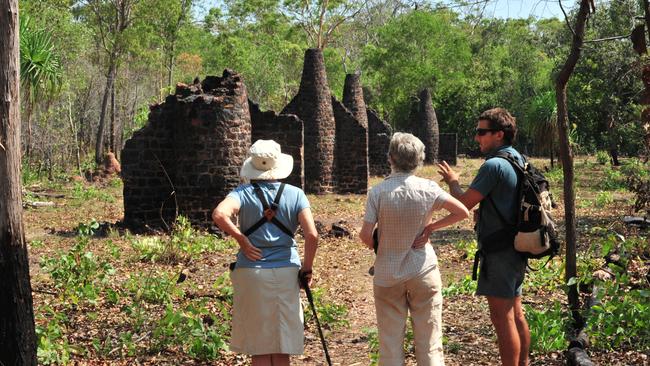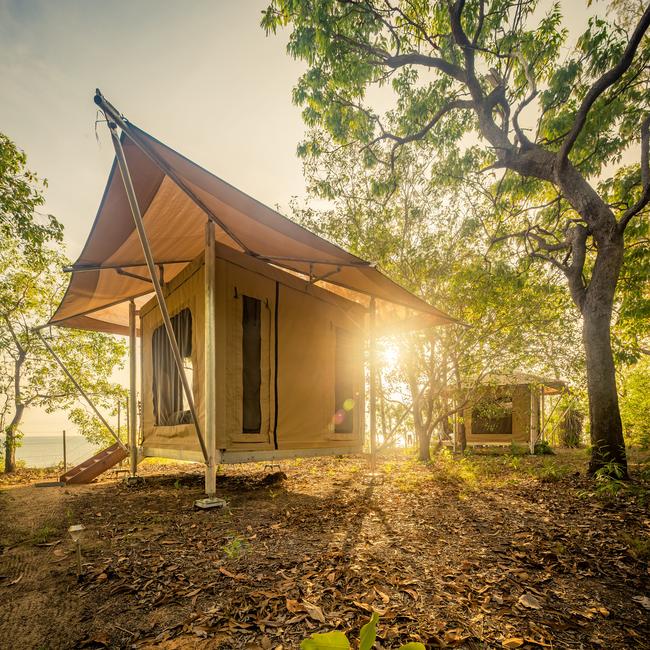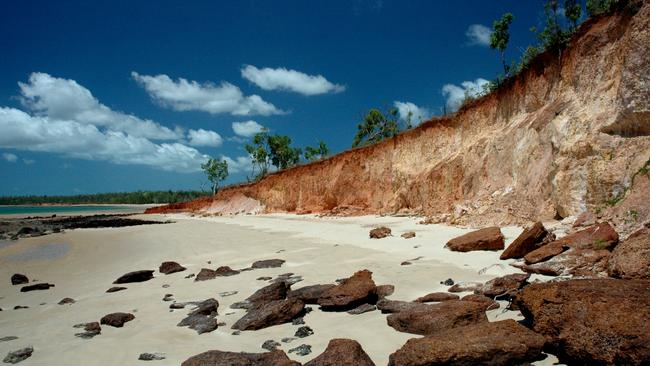Northern Territory’s Victoria Settlement is a lost city of the north
Explore the remains of an abandoned European settlement in northwestern Arnhem Land.

Be careful what you wish for. In 1839, when the women of Port Essington’s Victoria Settlement complained about the hardships of living in a tent, the men in charge decided to build them houses. Sturdy stone houses with thick windowless walls and big indoor fireplaces to cook over, just like those back in Cornwall where the stonemasons had learnt their trade before they found themselves building a would-be city in the middle of a tropical monsoon forest on one of the most remote corners of the Australian continent. Fast forward a sweltering summer or two and I imagine those women were soon wishing for a breezy outdoor kitchen again.
Half smothered in vines and chest-high grasses and surrounded by paperbark swamps, those ironstone fireplaces, with their circular chimneys lined up like sacred stupas from a lost temple complex, are virtually all that’s left of Victoria Settlement. Established in 1838 on the Cobourg Peninsula in northwestern Arnhem Land, it was meant to be our northern capital city, the third of four ill-fated outposts that failed before Palmerston (Darwin) was successfully established in 1869. Battered by cyclones, decimated by malaria, plagued by loneliness and hunger, the settlement struggled for 11 years before being abandoned after tragically, almost everyone — including all the children brought there or born there — died.
Today the atmospheric ruins are part of Garig Gunak Barlu National Park, and are accessible only by boat. They include the remains of a hospital kitchen and bakehouse, a lime kiln, blacksmith’s forge, quartermaster’s store, ammunition magazine and cemetery as well as the row of “married quarters” and a small mountain of old Dutch gin, British rum and French champagne bottles (testimony perhaps to how the 200 or so inhabitants coped with hardship).
We’re visiting on a combined fishing and sightseeing trip around Port Essington run by Venture North, which also operates five-day safaris of the Cobourg Peninsula from Darwin. As we cruise along the wild uninhabited coastline, stopping now and again to cast a line and haul in a trevally, snapper or coral trout, guide Travis points out a beautiful but otherwise unremarkable sliver of white sand that juts into the sea. It is, he says, one of the most historic sites in Australia, although there’s no monument to say so, or sign that anyone has been there before.
Captain Cook had taken possession of the east coast of Australia from a tiny island at the tip of Cape York (now known as Possession Island) in 1770, but it was here at Record Point that Captain Bremer, who later became the first commander of Victoria Settlement, officially took ownership of the north coast for England in 1824. Legend has it they buried a bottle with details of the declaration in the sand, but it has never been found.
They weren’t the first non-indigenous visitors to the area. The beaches and bays of Port Essington had been home to seasonal settlements of hundreds of Macassan fishermen since the 17th century. They travelled from Celebes (modern-day Sulawesi in Indonesia) in search of trepang (sea cucumbers), trading with the local Arrarrkbi people — and later the British — building shelters and sheds, planting tamarind trees and leaving behind great iron woks they used to process the trepang.

At the end of the day we head to Venture North’s Cobourg Coastal Camp, deep inside the national park. We’re greeted by cheerful camp host Holly, who serves us a sunset glass of bubbly and canapes on a clifftop lookout as she points out a large saltwater crocodile in the shallows of the beach below, just one small rocky headland away from where we’d waded ashore from our fishing boat not that long ago. It’s a startling reminder that Arnhem Land really is one of the planet’s wild-est places.
Catering to no more than 16 guests, the camp comprises eight hard-floored safari tents, each with twin beds and a deck, strung out along the edge of a cliff overlooking the beach; all have superb water views. The best vista, though, is from the loo, which has a large open-air window looking out to sea. You know you’re somewhere seriously wild when you can see sea eagles, sharks and crocodiles from the toilet seat. There are three outdoor showers with solar hot water, although temperatures are steamy enough that cold showers bring welcome relief. Bathrooms are decorated with shells and much of the furniture is made with pandanus wood.
Meals, including freshly caught seafood, barbecues and camp-oven roasts, are served in an open-sided central lodge, and there’s a clifftop pagoda with lounges, perfect for lazing about with one of the books from the library, or simply staring out to sea, looking for turtles and ticking off the long list of birds that swoop and soar above the rockpools below.

We spend the following day exploring the park by land, visiting the cultural centre at Black Point, where we see rusted relics left by the Macassans, bush tucker displays and learn about the unique culture and landscape of this remote wilderness that is home to one of the Top End’s most sacred creation sites. This is the place where Namarrgon (Lightning Man) began his journey across Arnhem Land and Kakadu; his story features in the rock art galleries at Burrungkuy (Nourlangie). Garig Gunak Barlu was the first national park in Australia to be co-managed with the traditional owners, and covers more than 4500sq km, including the largest marine protected area in the Northern Territory. It also contains the first wetland in the world to be recognised as one of “international importance” under the RAMSAR Convention.
The peninsula is home to the largest wild herd of banteng in the world. Introduced by the colonists at Victoria Settlement, undomesticated banteng, also known as Bali cattle, are endangered in their native habitat, but the Cobourg Peninsula is home to several thousand. We don’t see any but we see plenty of other wildlife, including turtles. We spy several nests in the dunes, trailed by a filigree of tiny tracks left by hatchlings as they scurry towards the sea, frequently accompanied by the larger tracks of predatory monitor lizards.
Most of the day is spent bumping our way along the 19km Beach Drive, a 4WD track that threads through the monsoon forest along the shore of the peninsula, past a string of beaches, each one more enticing than the last with their azure waters and white sands, more often than not flanked by red ochre cliffs and bookended with rocky platforms covered in oysters. The beaches are littered with some of the largest sea shells I’ve seen. As tempting as it is to wade in the shallows in the sweltering heat, this is not a place for swimming. We saw several sharks on our fishing trip and the memory of yesterday’s crocodile sighting is convincing. Watching them cruise past from the comfort of my clifftop tent is close enough for me.
Lee Atkinson was the guest of Venture North.
-
IN THE KNOW
Garig Gunak Barlu National Park is 560km northeast of Darwin. Venture North’s five-day trip through Kakadu, Arnhem Land and the Cobourg Peninsula from Darwin costs $3590 a person, twin-share, including all meals and accommodation. Trips depart May to October.

To join the conversation, please log in. Don't have an account? Register
Join the conversation, you are commenting as Logout